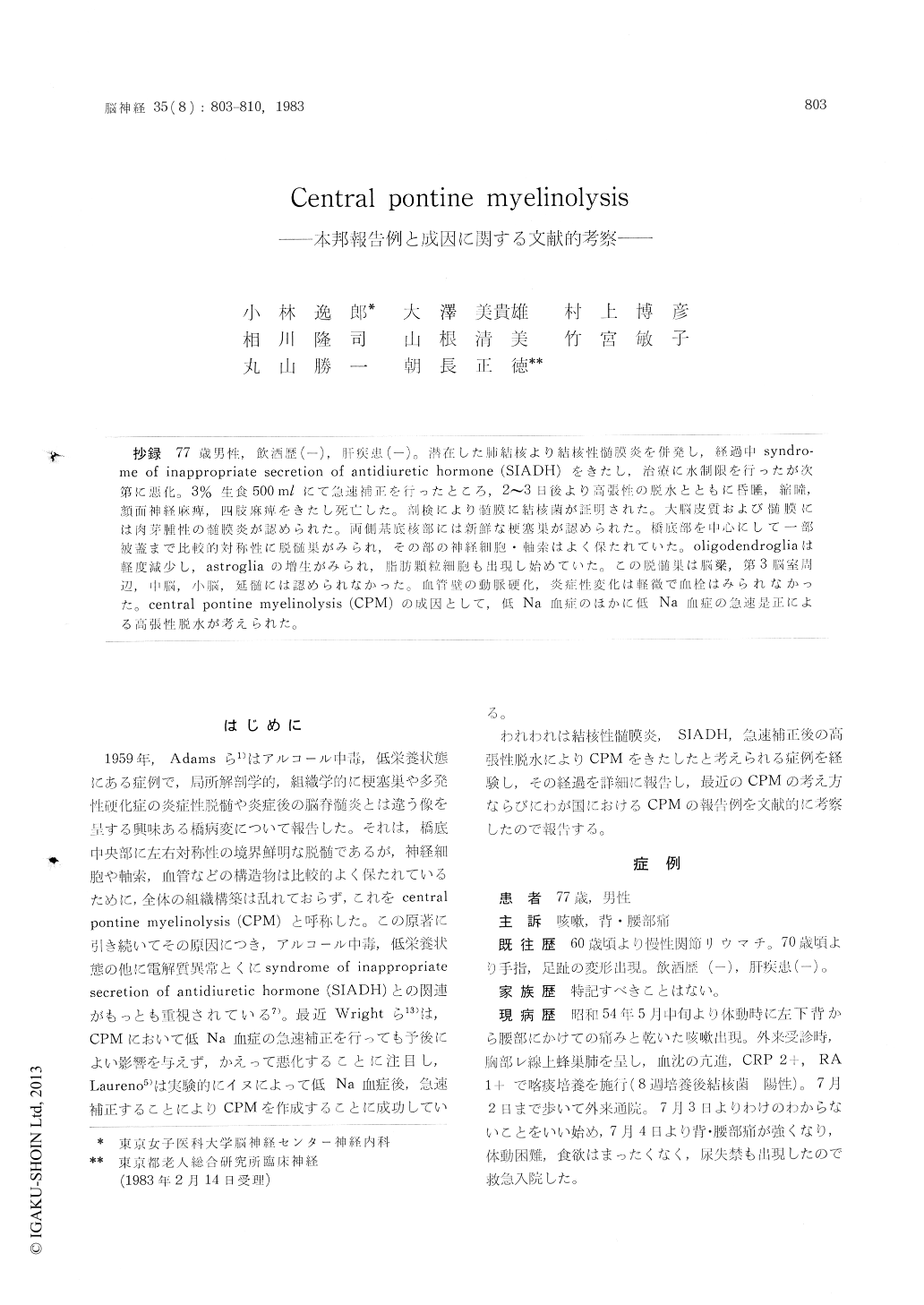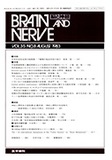Japanese
English
- 有料閲覧
- Abstract 文献概要
- 1ページ目 Look Inside
抄録 77歳男性,飲酒歴(—),肝疾患(—)。潜在した肺結核より結核性髄膜炎を併発し,経過中 syndro—me of inappropriate secretion of antidiuretic hormone (SIADH)をきたし,治療に水制限を行ったが次第に悪化。3%生食500mlにて急速補正を行ったところ,2〜3日後より高張性の脱水とともに昏睡,縮瞳,顔面神経麻痺,四肢麻痺をきたし死亡した。剖検により髄膜に結核菌が証明された。大脳皮質および髄膜には肉芽腫性の髄膜炎が認められた。両側基底核部には新鮮な梗塞巣が認められた。橋底部を中心にして一部被蓋まで比較的対称性に脱髄巣がみられ,その部の神経細胞.軸索はよく保たれていた。oligodendrogliaは軽度減少し,astrogliaの増生がみられ,脂肪顆粒細胞も出現し始めていた。この脱髄巣は脳梁,第3脳室周辺,中脳,小脳,延髄には認められなかった。血管壁の動脈硬化,炎症性変化はで血栓はみられなかった。central pontine myelinolysis (CPM)の成因として,低Na血症のほかに低Na血症の急速是正による高張性脱水が考えられた。
A 77-year-old, nonalcoholic man was admitted to the Omiya Red Cross Hospital with the com-plaint of fever and delirium state of two days' duration. Two months prior to admission he had had cough and sputum. Chest X-ray revealed hon-ey comb lungs. Cultures of sputum revealed my-cobacterium tuberculosis after eight weeks incu-bation. He had no liver disease in his past histo-ry. The patient appeared cachetic. His vital sighs were as follows ; temperature 38℃, blood pressu-re 132/68 mmHg, with a pulse rate of 84/min. He was delrium and excited. Findings of the cranial, motor and sensory nerve examination were nor-mal. Initial laboratory studies showed a serum sodium value of 133 mEq/l, potassium 4.5 mEq/l, chloride 98 mEq// ; a serum GOT value of 51 un-its, GPT 36 units ; a total protein content of 7.8 g/dl and ESR rate of 87 mm/hr.
Six days after admission, the patients' conscious-ness level began to stupor and nuchal rigidity was appeared. Spinal fluid examination revealed opening pressure 270 mm H2O, cell counts 720 (N 712, L 8)/cumm, sugar 57 mg/dl and protein 170 mg/dl. Spinal fluid cultures were positive in my-cobacterium tuberculosis after eight weeks incu-bation. Laboratory studies showed a serum sodi-um value of 114 mEq//, potassium 4. 4 mEq/l, chlo-ride 86 mEq/l, a serum osmorality (SeOs) 225 m-Osm/l and urine osmorality (UOs) 958 mOsm/l. He was diagnosed a syndrome of inappropriate sec-retion of diuretic hormone (SIADH). The patient was treated by a strict limitation of water but his clinical course was getting worse. From fif-teenth to sixteenth hospital day, after 3% saline 500 ml infusion, his consciousness level became somnolence. Three days after saline infusion, la-boratory studies showed a serum sodium value of 158 mEq/l, potassium 4. 8 mEq/l, chloride 124 mEq//, SeOs 340 mOsm/l, UOs 1, 024 mOsm/l ; that was hyperosmolar dehydration. His clinical symptoms were coma, anisocoria, facial diplegia and tetra-plegia. He died twenty seventh hospital day.
Autopsy examination : A thin meningial exuda-te overlay throughout the cerebral subarachnoid space. There was no exudate the basis points and medulla. Cerebral, basilar and vertebral arteries appeared normal. With section of the fixed brain, the region of the basal ganglia showed the evi-dence of gross softening bilaterally. Gross secti-ons through the 3rd ventricule, corpus callosum and thalamus showed no evidence of softening. Gross sections through the pontine region were softer than surrounding tissues. Microscopically, with hematoxylin and eosin (H-E) stain, the meningial reaction was characterized by a prolif-eraion of lymphocytes and mononuclear cells with Langhans giant cells forming granulomas. The pontine lesion showed central, symmetric loss of eosinophilic staining material in the pons proper and the lower pontine tegmentum. Numerous fat-filled macrophages were seen throughout all sec-tions in the area of defect. The nerve cell bodies appeared intact. Special stains for myelin (Klü-ver-Barrera stain) revealed abrupt central, sym-metric demyelinization of nerve fibers within the central portion of the pons. With special nerve fiber stains (Bodian stain), fiber tracts of the pons showed orientation into transverse and longitu-dinal directions. In none of the sections did ves-sels show occlusion. Sections of corpus callsum,mammillary bodies, medulla and cerebellum did not show the demyelination of nerve fibers.
These findings were thought central pontine myelinolysis. The association between the electro-lyte disturbance and the review of the literature in Japan are discussed.

Copyright © 1983, Igaku-Shoin Ltd. All rights reserved.


